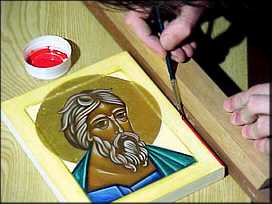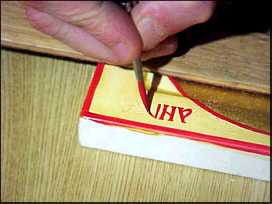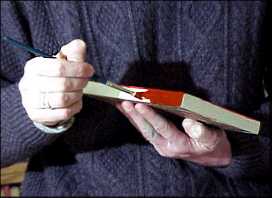|
 |  |  ICON TECHNIQUE: Finishing the icon. ICON TECHNIQUE: Finishing the icon. |
|
Background, halos and frames
Although the background of many icons are gilded it is also possible to use color for the background. Use either a transparent and diluted mixture of yellow ochre, or an opaque color such as Naples yellow diluted slightly with either yellow ochre or Veronese green. Zinc oxide mixed with a little yellow ochre is another possibility along with others. Test your mixture before applying by the puddling technique.
 A red line is traced around the outer edge of the halo and a red line is drawn on the outer edge of the frame. This should be a darkened red and a ruler can be used to trace the line along the outer edge.
A red line is traced around the outer edge of the halo and a red line is drawn on the outer edge of the frame. This should be a darkened red and a ruler can be used to trace the line along the outer edge.
Calligraphy
Calligraphy as well as gilding is an art in itself. It is highly recommended that one do the inscription over and over on paper before transferring on the board. The letterings confers on the icon the spiritual presence of the persons represented. And, after being blessed by a priest, they are considered worthy of either individual or public veneration.
It is very important to determine an appropriate size for the inscription in comparison to the size of the icon. Too large of an inscription alters the harmony of the image. It should be discrete but readable.
One of the traditional liturgical languages of the Church (Greek, Slavonic, Latin, Arab etc...) is generally chosen for the inscriptions. This depends mainly on the school to which the selected model is attached. It is also possible to use the vernacular language. In this case choose a style of calligraphy that is harmonious (many contemporary iconographers choose a style that is similar to " uncial ").

- The color for the calligraphy is the same as the color used for the halo and line around the outside border.
- The brush should be perfect to create an inscription that is precise and clear.
- The lines should be practiced first by tracing the original inscription or free-hand lines so that final lines will be fine.
- The lines should go from very thin, to thick, and taper off to thin.
- The emphasis for lettering should be vertical vs. horizontal, and the vertical bars of the letters are thicker than diagonal or horizontal bars.
- Mix the pigment with either ox gall or saliva. This allows the inscription adhere to the gold background. When it is dry, fix the inscription with transparent shellac.
The edge of the icon

- If the edge of the icon has been coated with gesso (levkas), it should be painted with dark red (red ochre or burned Sienna mixed with a little black), or with another dark color that harmonizes with the hues of the icon.
- If this edge is in its natural wood state, clean it well and protect it with a commercial varnish.
The final varnish
After the painting of the icon is finished, allow three months at least for the egg tempera layer to solidify before varnishing it.
The traditional icon varnish is olifa. This is an oil-based varnish made with linseed oil to which a drier, such as cobalt drier or stand oil, has been added. Today however there are a wide variety of varnishes that give all the advantages of olifa (transparency, blending of color, luminosity), without its problems (oxidation, dust, and difficulties of application). Who could say if Andrei Rublev, had he lived today, would have choosen olifa over one of these varnishes for his icons ? Ans it is noteworthy that many contemporary icon painters use these modern varnishes to cover their icons.
- Olifa
- Materials:
-
One liter of faded linseed oil (oil that has been exposed to the sun for several days).
- Olifa preparation:
- Heat the linseed oil to 280 degrees. Add 2,5 g of cobalt acetate.
- Cook while stirring.
- Alternate preparation of olifa:
- Heat linseed oil, that has been exposed to the sun for a long time, slowly over five hours time until it reaches 150 degrees.
- Varnishing:
- Pour a thick layer of olifa over the entire icon.
- Remove the excess olifa with your hand and recover any excess for reuse.
- Allow it to dry for two hours and then remove any remaining olifa with China paper. "Viva" paper towels are also effective.
- Check every fifteen minutes for two to three hours. Spread olifa onto any dry areas of the icon that appears.
- When the olifa "takes" smooth it quickly and delicately with the palm of the hand.
- Let it dry in a place for two months in away that is free from dust.
- Varia:
- Olifa should be reheated every 6 months.
- White egg varnish
- Beat an egg white until it is stiff and can be cut with a knife. To this add a glass of water and cover until the next day. Pour the liquid at the bottom into another container. This is the varnish.
- Properly speaking, egg white varnish is not an actual varnish, but a film that both unifies the the different degrees of dullness in the colors and protects the surface from the air. It is used as a protector for the icon when the varnishis to be added later. The egg tempera takes on greater brilliance as the egg solidifies. This egg white is sufficient to protect a painting and as many layers as one wishes may be applied. Also one can paint over the egg varnish.
- Allow the icon to dry for about a month before varnish it with the egg white. To apply the varnish, soak a broad flexible brush in the liquid. Wipe off any excess and apply a uniform thin layer over the painting.
- Apply two or three layers until a semi-brillant uniform quality is obtained. Do not put egg white on the gilded parts of the icon.
- If a painting has been in a humid environment during a long time after it is finished it is possible that moldwill form. To remove, simply wipe the mold off with a soft brush and apply final varnish.
- The synthetic water varnish
- The best synthetic varnishes one may use for the icon are the Lascaux and Liquitex. Both have a milky appearance. They are sold in both matte and gloss. It is best to mix both the matte and gloss in equal parts to obtain a satin effect.
- Method:
- To varnish add 40% water.
- Clean all dust, etc... from the icon.
- Mix well and use a flexible 10 to 15 mm brush.
- Apply two very thin layers in different directions. Do not apply to the previous layer until the first layer is completely dry.
- The applied layer may appear to have a milky quality, but it will become transparent after it dries for five or ten minutes. Don't touch while the varnish is drying.
- Disadvantage of this process:
- It is not possibleto make any final corrections after use of this varnish. It can only be removed with a trichloretylene solution.
- The shellac varnish
- It is possible to varnish the icon with a diluted mixture of shellac. Simply mix the shellac with thirty-percent ninety proof alcohol.


 A red line is traced around the outer edge of the halo and a red line is drawn on the outer edge of the frame. This should be a darkened red and a ruler can be used to trace the line along the outer edge.
A red line is traced around the outer edge of the halo and a red line is drawn on the outer edge of the frame. This should be a darkened red and a ruler can be used to trace the line along the outer edge.

